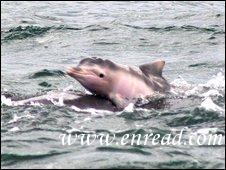| ||||||||||||||||||||||||||||||||||||||||||||||||||||||||
|
Adult tucuxi dolphins have been seen trying to kill a newborn calf1 of their own species. 成年海豚企图杀死同种族的刚出生的小海豚。 Baby tucuxi moments before the attack It is the first record of these dolphins attempting infanticide(杀婴). Although common in many mammal species, infanticide is rarely recorded among cetaceans(鲸类), the group of animals that includes whales and dolphins. Until now, the behaviour has only been reported twice in bottlenose dolphins(宽吻海豚); but the new episode suggests it may be more widespread than was thought. Tucuxi dolphins (Sotalia guianensis) live either in the freshwater of the Amazonian basin, or in the ocean off the coast of Brazil to Nicaragua. Adult male marine2 tucuxis are known to be aggressive to one another during the breeding season, but they had never been seen being aggressive or violent towards younger members of their species. That is until Mariana Nery, of the Southern University of Chile in Valdivia, and Sheila Simao, of the Federal Rural University of Rio de Janeiro, Brazil, were surveying the dolphins in Sepetiba Bay, Brazil. On the morning of 5 December 2006, when the sea was calm, they saw a group of six adult tucuxi dolphins approach a mother with her newborn calf. Two adults separated the baby from its mother. The female began to take evasive(逃避的,回避的) action, swimming to try to avoid the interlopers(闯入者). But the other four adults herded3(群集) her, hitting her body with their flukes(锚爪) and ramming4(锤击) her. Any attempt by the mother to escape towards her offspring(子孙,后代) was prevented by the herding5 pack, which chased her and blocked her path. The female dolphin frequently exposed her belly6 at the water surface, either as a passive behaviour or to signal that she would be sexually receptive to the males. Four metres away, the two remaining adults rammed7 the calf and held it underwater. They then threw it in the air and again pushed it underwater. Afterwards the calf was disorientated(使……迷惑) and swam with difficulty. Although the researchers saw the mother a few days later, they never again saw the calf. "We believe the injuries the newborn calf received from this encounter were fatal," the researchers report in the journal Marine Mammal Science. "This is the first time we've seen this type of aggression," explained Ms Nery. "It is difficult to say if they really attempted to kill the calf or if it was playful behaviour that went too far. But they clearly looked to separate the calf from the mother." They believe the incidence adds to growing evidence that wild dolphins may practise infanticide. In other animals, males often kill babies they did not father to induce their mother to become sexually receptive once more. "Female dolphins become sexually receptive within a few days of losing a calf," says Ms Nery. That, combined with the sexual interest shown by the group in the mother, suggests they killed the calf for similar reasons. 点击  收听单词发音 收听单词发音
|
||||||||||||||||||||||||||||||||||||||||||||||||||||||||
- 发表评论
-
- 最新评论 进入详细评论页>>




